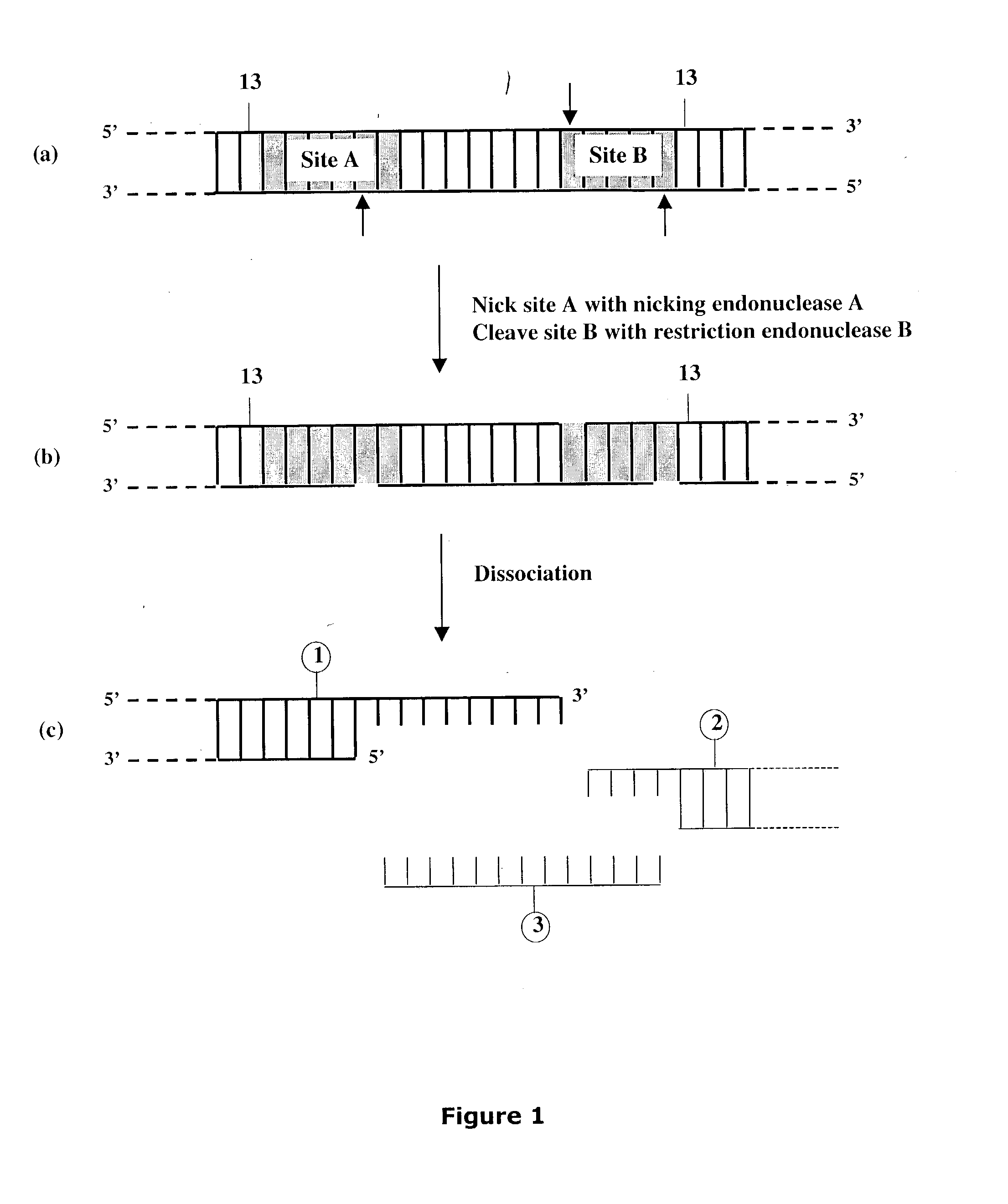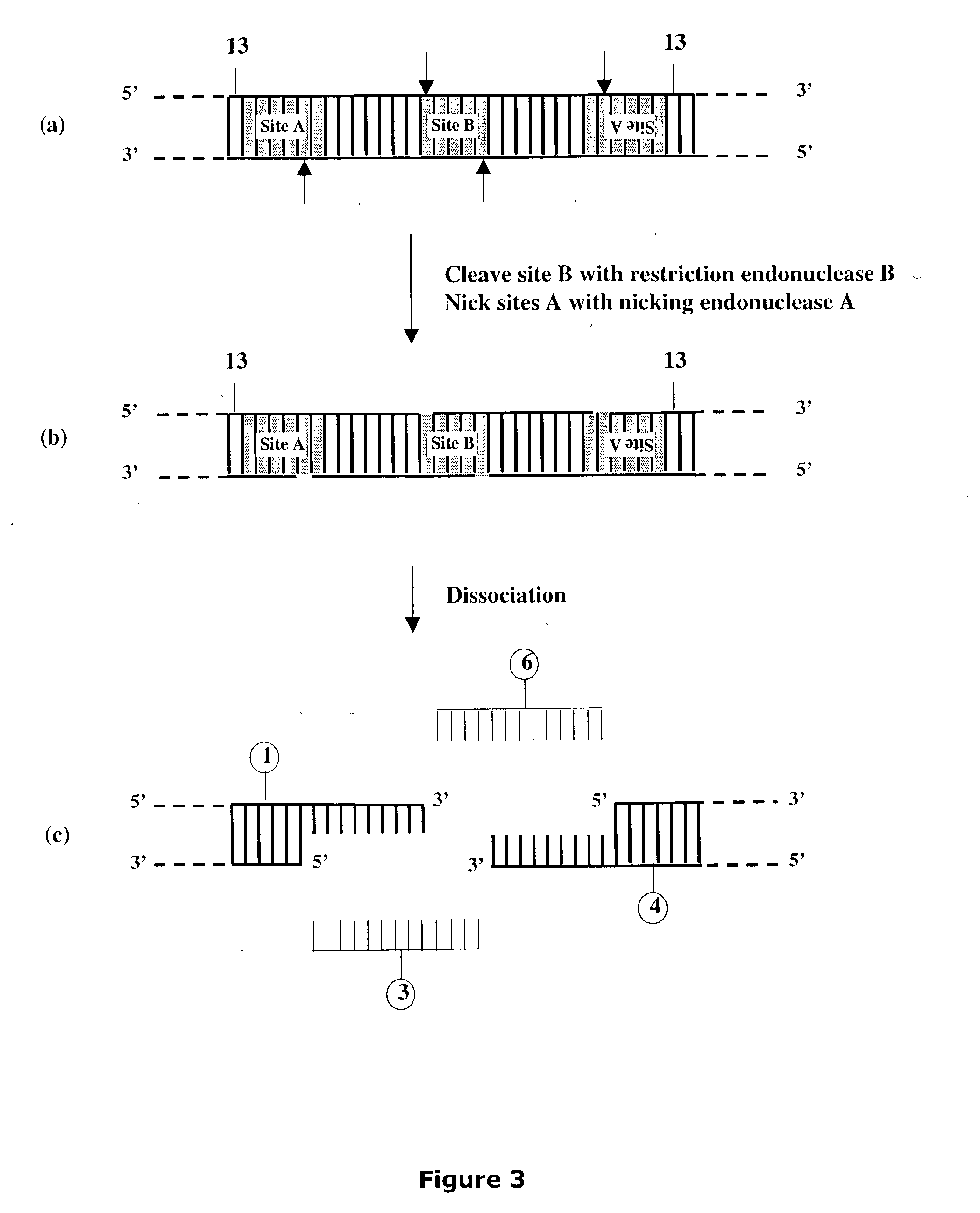Methods and compositions for DNA manipulation
a technology of dna and composition, applied in the direction of nucleotide libraries, directed macromolecular evolution, lyase, etc., can solve the problems of preventing efficient insertion, poor yield of vector compatible molecules, and preventing efficient insertion
- Summary
- Abstract
- Description
- Claims
- Application Information
AI Technical Summary
Problems solved by technology
Method used
Image
Examples
example ii
[0322] Preparation of Artificial Nicking Agents Specific for Deoxyuridine (U).
[0323] This Example describes the preparation of two artificial nicking agents, USER.TM. Enzyme and USER.TM. Enzyme 2 each capable of nicking a double-stranded DNA molecule at a deoxyuridine, generating a nucleotide gap and leaving 5' phosphate and 3' phosphate at the nick location. Each artificial nicking agent consists of two components. The USER.TM. enzyme contains UDG DNA glycosylase and EndoVIII DNA glycosylase / lyase while the USER.TM. Enzyme 2 contains UDG DNA glycosylase and FPG DNA glycosylase / lyase. One activity unit of the artificial nicking agent was defined as having in the mixture, sufficient amounts of the individual components required to cleave to completion, 10 pmol of a 34-mer oligonucleotide duplex containing a single deoxyuridine paired with a deoxyadenine in 10 .mu.l of reaction buffer for 15 minutes at 37.degree. C. Consequently, the optimal ratio of components in the mixture for prod...
example iii
[0329] Protocol and Kit for Cloning Target Molecule into pNEB205A Vector.
[0330] This Example describes cloning of target molecules after DNA amplification using primers containing deoxyuridine (FIGS. 26A and 26B). The amplified products are treated with the nicking agent, USER.TM. Enzyme (see Example II), to create unique 3' single-stranded extensions, which can then anneal to the linearized vector pNEB205A carrying complementary 3' single-stranded extensions (see Example I Section A). The method is not dependent on restriction endonuclease cleavage, nor does it require DNA ligase for insertion of target product into vector.
[0331] A kit is provided here for use with a target molecule which has been amplified using Taq DNA Polymerase and uracil-containing primers as specified in FIGS. 26A and 26B.
[0332] The kit provides a cloning vector pNEB205A that has already been linearized and contains single-stranded extensions as described in Example I, Section A and a nicking agent, USER.TM. ...
example iv
[0355] Cloning of the Chloramphenicol Resistance Gene (cat) into Vector pNEB205
[0356] Using the methodology described in Example III, the cat (Cm.sup.r) gene was amplified as a 950 bp fragment of the pGPS2.1 plasmid with Taq DNA Polymerase and primers listed below:
3 Left primer: 5'-GGAGACAUCGGATCCATACCTGTGACGGAAG (SEQ ID NO:33) Right primer: 5'-GGGAAAGUGGATCCAGGCGTTTAAGG-GCACC (SEQ ID NO:34)
[0357] The 50 .mu.l PCR reactions contained 5 .mu.l of 10.times.GenAmp PCR buffer (Applied Biosystems, Foster City, Calif.), 20 ng of the pGPS2.1 (New England Biolabs, Inc., Beverly, Mass.) DNA, 200 .mu.M dNTPs, 0.2 .mu.M of each primer and 2 units of Taq DNA Polymerase. The cat gene was amplified for 8, 9, 10, 11, 13, 16, 20, 25 and 30 cycles using the cycling protocol below:
4 94.degree. C. 5 min 94.degree. C. 30 sec 55.degree. C. 1 min one cycle 72.degree. C. 40 sec 72.degree. C. 5 min
[0358] The amount of PCR product in a 10 .mu.l sample (20% of the total PCR volume) was evaluated by gel electr...
PUM
| Property | Measurement | Unit |
|---|---|---|
| Mass | aaaaa | aaaaa |
| Mass | aaaaa | aaaaa |
| Mass | aaaaa | aaaaa |
Abstract
Description
Claims
Application Information
 Login to View More
Login to View More - R&D
- Intellectual Property
- Life Sciences
- Materials
- Tech Scout
- Unparalleled Data Quality
- Higher Quality Content
- 60% Fewer Hallucinations
Browse by: Latest US Patents, China's latest patents, Technical Efficacy Thesaurus, Application Domain, Technology Topic, Popular Technical Reports.
© 2025 PatSnap. All rights reserved.Legal|Privacy policy|Modern Slavery Act Transparency Statement|Sitemap|About US| Contact US: help@patsnap.com



